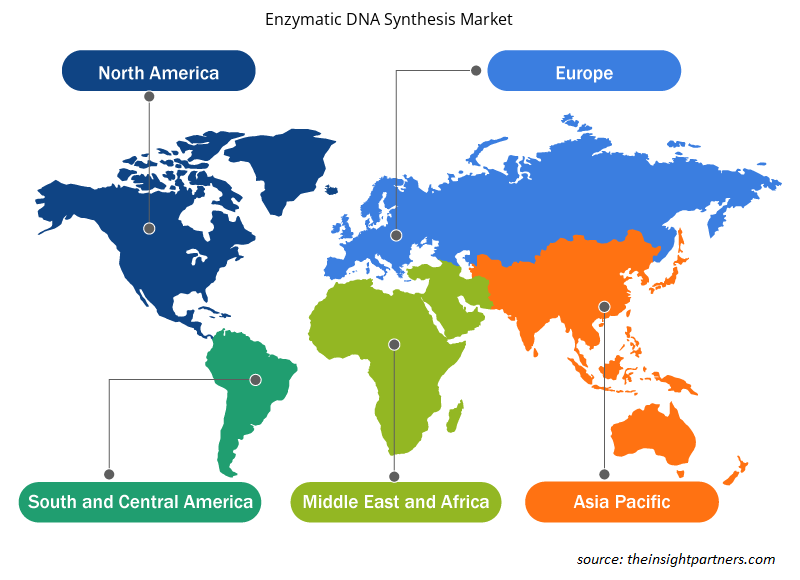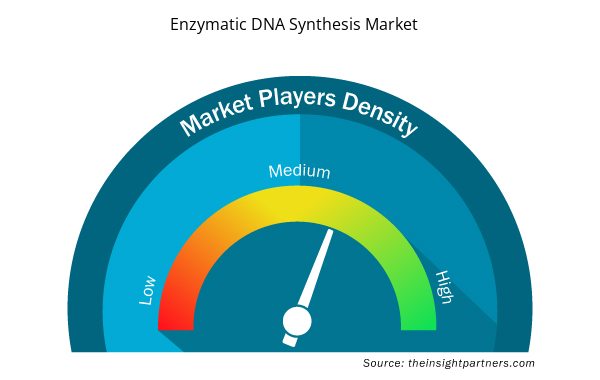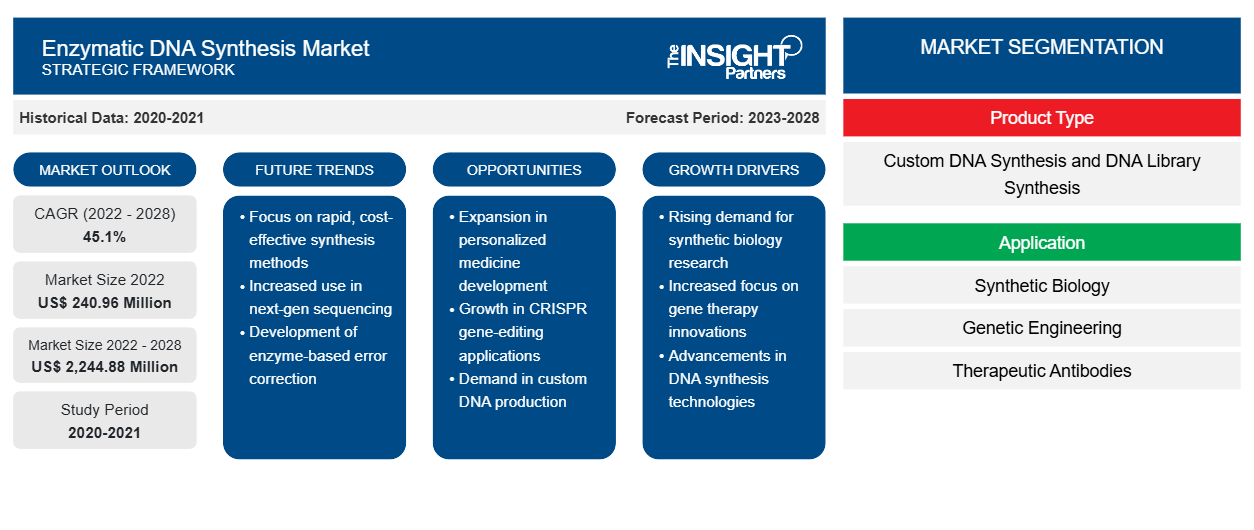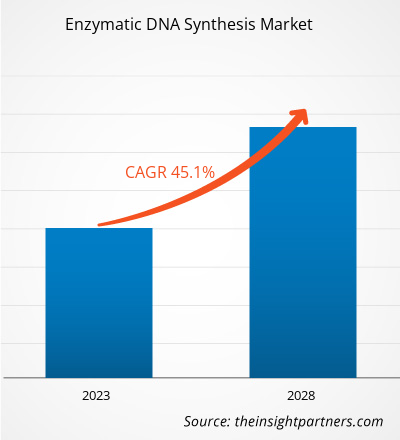[Rapporto di ricerca] Si prevede che il mercato della sintesi enzimatica del DNA crescerà da 240,96 milioni di dollari nel 2022 a 2.244,88 milioni di dollari entro il 2028; si stima che registrerà un CAGR del 45,1% dal 2022 al 2028.
La sintesi enzimatica del DNA è una tecnica consolidata di sintesi del DNA, utile nella biologia sintetica, nell'ingegneria genetica, nella produzione di anticorpi terapeutici, nella progettazione di vaccini e in altre procedure biologiche avanzate. Si è anche dimostrata utile nel mantenimento di librerie di DNA e nella sintesi di molecole di DNA personalizzate.
Approfondimenti sul mercato della sintesi enzimatica del DNA
La crescente prevalenza di disturbi genetici stimola la crescita del mercato della sintesi enzimatica del DNA
Sindrome di Down, disturbo dello spettro autistico, cancro, diabete, fibrosi cistica e anemia falciforme sono solo alcuni dei disturbi genetici più noti. Secondo Global Genes, sono state identificate più di 10.000 diverse malattie genetiche e rare e circa 400 milioni di persone soffrono di malattie rare. Alcune malattie genetiche causano sintomi alla nascita, mentre altre si sviluppano nel tempo. Il peso globale delle malattie genetiche sembra aumentare. Secondo il National Center for Biotechnology Information (NCBI), un'organizzazione medica con sede negli Stati Uniti, a novembre 2021, le malattie genetiche sono state identificate nel 9,4% dei pazienti pediatrici, di cui il 44,7% erano neonati gravemente malati. Inoltre, 13,17 milioni di pazienti negli Stati Uniti soffrono di disturbi genetici unici. Secondo il rapporto del 2022 dei Centers for Disease Control and Prevention (CDC), l'anemia falciforme colpisce circa 100.000 americani e si verifica in 1 su 356 nati afroamericani. La fibrosi cistica, un'altra malattia genetica comune in tutto il mondo, colpisce circa 30.000 persone negli Stati Uniti e circa 1.000 nuovi casi vengono curati ogni anno. La sintesi enzimatica del DNA è una tecnica di sintesi del DNA consolidata, utile nella biologia sintetica, nell'ingegneria genetica e negli studi sugli anticorpi terapeutici. In combinazione con i test enzimatici, la sintesi del DNA mostra maggiori possibilità diagnostiche. Questo metodo fornisce informazioni importanti sulle persone a rischio e le aiuta a prendere decisioni importanti in merito alla diagnosi della malattia e ai farmaci. Quindi, con la crescente prevalenza di disturbi genetici in tutto il mondo, le persone stanno diventando più consapevoli della necessità di una diagnosi precoce di questi difetti genetici, il che spinge la crescita del mercato della sintesi enzimatica del DNA
Personalizza questo report in base alle tue esigenze
Riceverai la personalizzazione gratuita di qualsiasi report, comprese parti di questo report, o analisi a livello nazionale, pacchetto dati Excel, oltre a usufruire di grandi offerte e sconti per start-up e università
- Scopri le principali tendenze di mercato in questo rapporto.Questo campione GRATUITO includerà analisi di dati che spaziano dalle tendenze di mercato alle stime e alle previsioni.
Costi elevati e procedure complesse ostacolano la crescita del mercato della sintesi enzimatica del DNA
Le tecniche di sintesi enzimatica del DNA non sono sufficientemente mature e sono necessarie ulteriori ottimizzazioni prima di poter essere diffuse su larga scala. La maggior parte si basa sull'enzima naturale terminal deoxynucleotidyl transferasi (TdT), utilizzato nei sistemi biologici per aggiungere nuove basi a una sequenza di DNA. Il metodo basato su TdT è migliorato rispetto alla procedura chimica in quanto evita la produzione di rifiuti pericolosi. Tuttavia, gli elevati costi e la bassa accuratezza di questo enzima ne ostacolano l'uso nella sintesi del DNA in vitro. L'enzima TdT è troppo permissivo, aggiungendo basi sbagliate più spesso di quanto dovrebbe. Di conseguenza, gli oligo basati su TdT presentano più errori di sequenza e potrebbero richiedere gli stessi o persino più passaggi di controllo qualità post-sintesi, aumentando il tempo e il costo del processo di sintesi. Mentre lavorano con questo enzima, gli scienziati devono aggiungere più reagenti per costruire la loro sequenza target, il che aumenta ulteriormente il costo dell'intero processo di sintesi. Il costo per base del DNA sintetico ottenuto utilizzando TdT è molto più elevato rispetto ai materiali genetici sintetizzati in modo convenzionale. Pertanto, i costi elevati e le procedure complesse limitano la crescita del mercato della sintesi enzimatica del DNA.deoxynucleotidyl transferase (TdT), which is used in biological systems to add new bases to a DNA sequence. TdT-based method is an improved one over the chemical procedure as it avoids the production of hazardous waste. However, the high costs and low accuracy of this enzyme hinder its use in in vitro DNA synthesis. The TdT enzyme is too permissive, adding wrong bases more often than it should. As a result, TdT-based oligos have more sequence errors and may require the same or even more post-synthesis quality control steps, increasing the time and cost of the synthesis process. While working with this enzyme, scientists need to add more reagents to build their target sequence, which further adds to the cost of the entire synthesis process. The cost per base of synthetic DNA obtained using TdT is much high than conventionally synthesized genetic materials. Thus, high costs and complex procedures limit the growth of the enzymatic DNA synthesis market.
Informazioni basate sul tipo di prodotto
In base al tipo di prodotto, il mercato della sintesi enzimatica del DNA è segmentato in sintesi di DNA personalizzata e sintesi di librerie di DNA. Il segmento della sintesi di librerie di DNA ha detenuto la quota di mercato più grande nel 2021. Inoltre, si prevede che il segmento della sintesi di DNA personalizzata registrerà il CAGR più elevato durante il periodo di previsione (2022-2028).
Approfondimenti basati sulle applicazioni
In base all'applicazione, il mercato della sintesi enzimatica del DNA è segmentato in biologia sintetica , ingegneria genetica , anticorpi terapeutici, progettazione di vaccini e altre applicazioni. Il segmento della biologia sintetica ha detenuto la quota maggiore del mercato nel 2021. Si prevede che il mercato della sintesi enzimatica del DNA per l'applicazione di anticorpi terapeutici crescerà al CAGR più elevato durante il periodo di previsione.
Informazioni basate sull'utente finale
In base all'utente finale, il mercato della sintesi enzimatica del DNA è segmentato in istituti accademici e di ricerca, aziende biotecnologiche e farmaceutiche, laboratori diagnostici e altri. Il segmento delle aziende biotecnologiche e farmaceutiche ha detenuto la quota maggiore del mercato nel 2021. Si prevede che il segmento degli istituti accademici e di ricerca registrerà il CAGR più elevato nel mercato durante il periodo di previsione (2022-2028).
Approfondimenti regionali sul mercato della sintesi enzimatica del DNA
Le tendenze regionali e i fattori che influenzano il mercato della sintesi enzimatica del DNA durante il periodo di previsione sono stati ampiamente spiegati dagli analisti di Insight Partners. Questa sezione discute anche i segmenti e la geografia del mercato della sintesi enzimatica del DNA in Nord America, Europa, Asia Pacifico, Medio Oriente e Africa e America meridionale e centrale.

- Ottieni i dati specifici regionali per il mercato della sintesi enzimatica del DNA
Ambito del rapporto di mercato sulla sintesi enzimatica del DNA
| Attributo del report | Dettagli |
|---|---|
| Dimensioni del mercato nel 2022 | 240,96 milioni di dollari USA |
| Dimensioni del mercato entro il 2028 | 2.244,88 milioni di dollari USA |
| CAGR globale (2022 - 2028) | 45,1% |
| Dati storici | 2020-2021 |
| Periodo di previsione | 2023-2028 |
| Segmenti coperti | Per tipo di prodotto
|
| Regioni e Paesi coperti | America del Nord
|
| Leader di mercato e profili aziendali chiave |
|
Densità degli attori del mercato della sintesi enzimatica del DNA: comprendere il suo impatto sulle dinamiche aziendali
Il mercato della sintesi enzimatica del DNA sta crescendo rapidamente, spinto dalla crescente domanda degli utenti finali dovuta a fattori quali l'evoluzione delle preferenze dei consumatori, i progressi tecnologici e una maggiore consapevolezza dei benefici del prodotto. Con l'aumento della domanda, le aziende stanno ampliando le loro offerte, innovando per soddisfare le esigenze dei consumatori e capitalizzando sulle tendenze emergenti, il che alimenta ulteriormente la crescita del mercato.
La densità degli operatori di mercato si riferisce alla distribuzione di aziende o società che operano in un particolare mercato o settore. Indica quanti concorrenti (operatori di mercato) sono presenti in un dato spazio di mercato in relazione alle sue dimensioni o al valore di mercato totale.
Le principali aziende che operano nel mercato della sintesi enzimatica del DNA sono:
- Telesis Bio Inc
- Evonetix
- Ansa Biotechnologies, Inc.
- Biografia di Camena
- Società per azioni GenScript Biotech Corp.
Disclaimer : le aziende elencate sopra non sono classificate secondo un ordine particolare.

- Ottieni una panoramica dei principali attori del mercato della sintesi enzimatica del DNA
Approfondimenti basati sulla tecnologia
In base alla tecnologia, il mercato della sintesi enzimatica del DNA è segmentato in SOLA, CRISPR, PCR e altri. Il segmento PCR ha la quota maggiore nel 2021 e si prevede che continuerà un trend simile durante il periodo di previsione. D'altro canto, si prevede che il segmento CRISPR assisterà al CAGR più elevato durante il periodo di previsione.
Strategie che sono ampiamente adottate dalle aziende nel mercato delle fusioni e acquisizioni della sintesi enzimatica del DNA. Di seguito sono elencati alcuni recenti sviluppi da parte dei principali attori del mercato:
- Ad aprile 2022, GenScript ha lanciato il primo chip semiconduttore a più alta produttività del settore per la sintesi del DNA alla conferenza globale annuale Built With Biology. Sviluppato utilizzando la tecnologia proprietaria di chip semiconduttori in miniatura di GenScript, questo chip di sintesi del DNA ad alta densità consente la sintesi di 8,4 milioni di oligo unici contemporaneamente.
- Ad aprile 2022, Evonetix Ltd ha ottenuto il brevetto EP3551331B1 per la sua tecnologia proprietaria di controllo termico per la sintesi del DNA e per la progettazione e la produzione dei suoi chip in silicio in Europa. Oltre ad ampliare il portafoglio IP di Evonetix, il brevetto è percepito come un passaggio fondamentale nella strategia aziendale per sviluppare una piattaforma di sintesi del DNA da banco.
- A marzo 2022, Molecular Assemblies, Inc. ha raccolto 25,8 milioni di dollari di finanziamenti di serie B con la partecipazione di un nuovo investitore, Casdin Capital, insieme a tutti i principali investitori di serie A: Agilent Technologies, iSelect Fund, Codexis, LYFE Capital e Argonautic Ventures. La società intende utilizzare i proventi del finanziamento per avviare un programma per clienti chiave e far progredire la tecnologia proprietaria di sintesi del DNA completamente enzimatica dell'azienda verso una commercializzazione anticipata.
- Nel novembre 2021, DNA Script ha ricevuto una sovvenzione di 2,2 milioni di dollari dal National Human Genome Research Institute (NHGRI) dei National Institutes of Health (NIH) per sostenere lo sviluppo di stampanti di nuova generazione in grado di stampare enzimaticamente DNA e RNA sintetici.
Profili aziendali
- Telesis Bio Inc
- Evonetix
- Ansa Biotechnologies, Inc.
- Biografia di Camena
- Società per azioni GenScript Biotech Corp.
- Assemblaggio molecolare
- Scrittura del DNA
- Luce tattile
- Tecnologie sinbio
- Twist Bioscienza
- Analisi storica (2 anni), anno base, previsione (7 anni) con CAGR
- Analisi PEST e SWOT
- Valore/volume delle dimensioni del mercato - Globale, regionale, nazionale
- Industria e panorama competitivo
- Set di dati Excel



Report Coverage
Revenue forecast, Company Analysis, Industry landscape, Growth factors, and Trends

Segment Covered
This text is related
to segments covered.

Regional Scope
North America, Europe, Asia Pacific, Middle East & Africa, South & Central America

Country Scope
This text is related
to country scope.
Domande frequenti
Enzymatic DNA synthesis (EDS) offers significant advantages in terms of accessibility and convenience, changing the pace and control of iteration and innovation with less environmental impact. The enzymes involved in DNA replication act coordinated to synthesize both leading and lagging strands of DNA simultaneously at the replication fork. Purported benefits of enzymatic synthesis include the ability to avoid the use of harsh chemical substances (which often result in toxic waste) and an ever-increasing ability to produce longer and longer strands of DNA, which in turn not only leads to a "more green" form of DNA synthesis, but also some incredibly powerful new uses for the longer DNA chains (e.g., vaccines, therapeutics, and data storage).
The factors that are driving the growth of the enzymatic DNA synthesis market are the rising prevalence of genetic disorders and surging number of product launches. Also, the growing demand for enzymatic DNA synthesis procedures is expected to provide opportunity for the enzymatic DNA synthesis market in forecasted period.
The enzymatic DNA synthesis market majorly consists of the players, such as Telesis Bio Inc, Evonetix, Ansa Biotechnologies, Inc., Camena Bio, GenScript Biotech Corp., Molecular Assemblie, DNA Script, Touchlight, Synbio Technologies, and Twist Bioscience.
The enzymatic DNA synthesis market is estimated to be valued at US$ 240.96 million in 2022.
The CAGR value of the enzymatic DNA synthesis market during the forecasted period of 2022-2028 is 45.1%.
The Asia Pacific region is expected to be the fastest-growing region in the enzymatic DNA synthesis market over the forecast period due to increasing government investment to provide healthcare facilities, growing advancements in healthcare infrastructure, greater adoption of advanced technologies, and rising healthcare spending in countries such as China, Japan, and India.
The enzymatic DNA synthesis market is expected to be valued at US$ 2,244.88 million in 2028.
The DNA library synthesis segment held the largest share of the market in 2022, owing to the various advantages offered by DNA library synthesis such as systematic, unbiased investigations such as high-throughput screening for discovery biology, directed evolution for protein engineering, and in vitro molecular optimization to generate mutant proteins with improved or novel properties. However, the custom DNA synthesis segment is estimated to register the highest CAGR in the market during the forecast period.
Trends and growth analysis reports related to Life Sciences : READ MORE..
The List of Companies - Enzymatic DNA Synthesis Market
- Telesis Bio Inc
- Evonetix
- Ansa Biotechnologies, Inc.
- Camena Bio
- GenScript Biotech Corp.
- Molecular Assemblies
- DNA Script
- Touchligh
- Synbio Technologies
- Twist Bioscience
The Insight Partners performs research in 4 major stages: Data Collection & Secondary Research, Primary Research, Data Analysis and Data Triangulation & Final Review.
- Data Collection and Secondary Research:
As a market research and consulting firm operating from a decade, we have published and advised several client across the globe. First step for any study will start with an assessment of currently available data and insights from existing reports. Further, historical and current market information is collected from Investor Presentations, Annual Reports, SEC Filings, etc., and other information related to company’s performance and market positioning are gathered from Paid Databases (Factiva, Hoovers, and Reuters) and various other publications available in public domain.
Several associations trade associates, technical forums, institutes, societies and organization are accessed to gain technical as well as market related insights through their publications such as research papers, blogs and press releases related to the studies are referred to get cues about the market. Further, white papers, journals, magazines, and other news articles published in last 3 years are scrutinized and analyzed to understand the current market trends.
- Primary Research:
The primarily interview analysis comprise of data obtained from industry participants interview and answers to survey questions gathered by in-house primary team.
For primary research, interviews are conducted with industry experts/CEOs/Marketing Managers/VPs/Subject Matter Experts from both demand and supply side to get a 360-degree view of the market. The primary team conducts several interviews based on the complexity of the markets to understand the various market trends and dynamics which makes research more credible and precise.
A typical research interview fulfils the following functions:
- Provides first-hand information on the market size, market trends, growth trends, competitive landscape, and outlook
- Validates and strengthens in-house secondary research findings
- Develops the analysis team’s expertise and market understanding
Primary research involves email interactions and telephone interviews for each market, category, segment, and sub-segment across geographies. The participants who typically take part in such a process include, but are not limited to:
- Industry participants: VPs, business development managers, market intelligence managers and national sales managers
- Outside experts: Valuation experts, research analysts and key opinion leaders specializing in the electronics and semiconductor industry.
Below is the breakup of our primary respondents by company, designation, and region:

Once we receive the confirmation from primary research sources or primary respondents, we finalize the base year market estimation and forecast the data as per the macroeconomic and microeconomic factors assessed during data collection.
- Data Analysis:
Once data is validated through both secondary as well as primary respondents, we finalize the market estimations by hypothesis formulation and factor analysis at regional and country level.
- Macro-Economic Factor Analysis:
We analyse macroeconomic indicators such the gross domestic product (GDP), increase in the demand for goods and services across industries, technological advancement, regional economic growth, governmental policies, the influence of COVID-19, PEST analysis, and other aspects. This analysis aids in setting benchmarks for various nations/regions and approximating market splits. Additionally, the general trend of the aforementioned components aid in determining the market's development possibilities.
- Country Level Data:
Various factors that are especially aligned to the country are taken into account to determine the market size for a certain area and country, including the presence of vendors, such as headquarters and offices, the country's GDP, demand patterns, and industry growth. To comprehend the market dynamics for the nation, a number of growth variables, inhibitors, application areas, and current market trends are researched. The aforementioned elements aid in determining the country's overall market's growth potential.
- Company Profile:
The “Table of Contents” is formulated by listing and analyzing more than 25 - 30 companies operating in the market ecosystem across geographies. However, we profile only 10 companies as a standard practice in our syndicate reports. These 10 companies comprise leading, emerging, and regional players. Nonetheless, our analysis is not restricted to the 10 listed companies, we also analyze other companies present in the market to develop a holistic view and understand the prevailing trends. The “Company Profiles” section in the report covers key facts, business description, products & services, financial information, SWOT analysis, and key developments. The financial information presented is extracted from the annual reports and official documents of the publicly listed companies. Upon collecting the information for the sections of respective companies, we verify them via various primary sources and then compile the data in respective company profiles. The company level information helps us in deriving the base number as well as in forecasting the market size.
- Developing Base Number:
Aggregation of sales statistics (2020-2022) and macro-economic factor, and other secondary and primary research insights are utilized to arrive at base number and related market shares for 2022. The data gaps are identified in this step and relevant market data is analyzed, collected from paid primary interviews or databases. On finalizing the base year market size, forecasts are developed on the basis of macro-economic, industry and market growth factors and company level analysis.
- Data Triangulation and Final Review:
The market findings and base year market size calculations are validated from supply as well as demand side. Demand side validations are based on macro-economic factor analysis and benchmarks for respective regions and countries. In case of supply side validations, revenues of major companies are estimated (in case not available) based on industry benchmark, approximate number of employees, product portfolio, and primary interviews revenues are gathered. Further revenue from target product/service segment is assessed to avoid overshooting of market statistics. In case of heavy deviations between supply and demand side values, all thes steps are repeated to achieve synchronization.
We follow an iterative model, wherein we share our research findings with Subject Matter Experts (SME’s) and Key Opinion Leaders (KOLs) until consensus view of the market is not formulated – this model negates any drastic deviation in the opinions of experts. Only validated and universally acceptable research findings are quoted in our reports.
We have important check points that we use to validate our research findings – which we call – data triangulation, where we validate the information, we generate from secondary sources with primary interviews and then we re-validate with our internal data bases and Subject matter experts. This comprehensive model enables us to deliver high quality, reliable data in shortest possible time.


 Ottieni un campione gratuito per questo repot
Ottieni un campione gratuito per questo repot